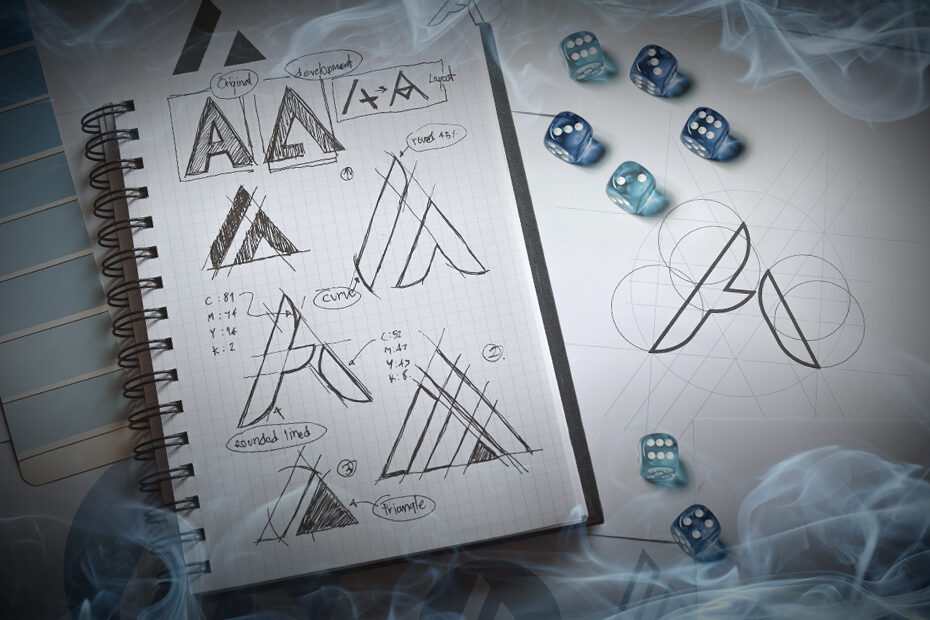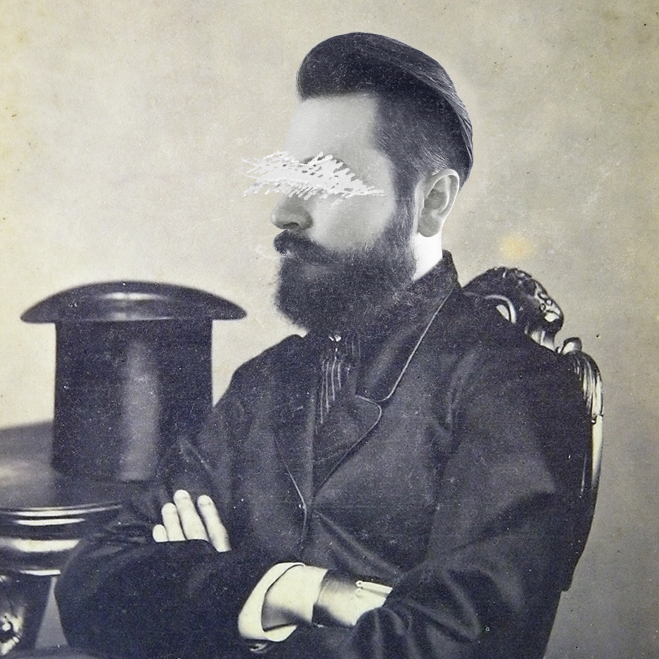Last week I started a blog series about graphic design tips for tabletop creators with Free Graphic Design Resources & Best Practices For TTRPG Creators. This week, we’ll explore a topic I see come up a lot on social media… logo design for TTRPGs! While I always recommend hiring a graphic designer for logo design, it’s not always in the budget for independent TTRPG companies.
Below I’ve compiled a concise guide to the logo design process based on my personal experience. I’ve designed a lot of logos over my career and these are just some of the things I’ve learned. Logo design is more complicated than most people realize. This article only scratches the surface of the topic. However, hopefully you’ll find something useful for designing your own logos!
What Is A Logo?
This might seem like a silly question. You clearly know what a logo is. After all, that’s why you’re reading this blog post! However, most people only see logos as a word and graphic to slap on all their products. But a true branding mark is so much more than that. As a TTRPG creator, a good logo can set you apart from your competitors and differentiate you in a saturated industry.
Your logo is your brand. It is a visual representation of what your product is, how you want to be perceived, and the first thing that comes to mind when someone thinks of your company. This stand-alone mark is so powerful that it eventually invokes an emotional response from your customers when they see it. You want a logo that is consistent, clean, and concisely tells your story.
Research & Development
Designing a logo is like designing any other product. You need to put in the time to research and develop your mark. It’s not the most fun or glamorous aspect of logo design. However, in my opinion it is the most important step in the process. A lack of research and planning can cost hours of additional work in the long run.
Visual Research
Research what other TTRPG companies are doing for their branding. What solutions work for them? What could use improvement? What catches your eye? When you explore what’s out there, you get a good sense of what is effective. Think about who your customers are and what would attract them to your product. The visual research step is also very good for avoiding accidental plagiarism!
Put Together A Mood Board
As you do your visual research, save your favorite concepts and create a mood board. In the olden days, this was done by printing out images, cutting up magazines, and pinning your collection to a bulletin board with push pins. Nowadays, a Pinterest board works just as well. It’s a free solution and creates less waste when the project is over!
Developing A Concept
Honestly, this is the most difficult part of the process. It’s important to remember that coming up with a completely original idea is difficult, if not impossible. Really, you’re aiming for a graphic mark that is recognizable yet simple. Something that communicates your message as clearly as possible while still having an edge of style. It’s difficult to achieve even for professional designers.
Think About Your Logo’s Applications
When creating a logo, it is important to think about its lifespan. Will it ever need to be animated for a kickstarter video? Does it need to be simple for more affordable printing or production? Does it work when blown up really big? Is it distinguishable when shrunk very small? Thinking about where your logo will be used in the future is important when creating your mark.
The Anatomy Of A Logo
Now that you’ve developed a logo concept, a general vibe for your brand, and thought about logo applications, we can move on to what makes a logo visually appealing. This topic is very subjective. However, there are some tried and true logo design principles that always apply.
The Basics Of Typography
Typography is the style of type. It is what distinguishes a beautiful piece of type from an unstyled block of font. While typography is a complicated subject, here are some basics to help your work look more professional. Be mindful of kerning, the space between letters. Play with setting your type in capital letters, title case, and all lowercase words. Consider connecting letters using ligatures, which are two letters joined together, such as fi. These little tricks go a long way when styling type.
Creating A Mark
A mark is the graphic artwork of your logo. This should be a simple yet elegant visual solution that conveys your brand. It needs to be able to stand alone as a graphic without its type counterpart. Usually, a logo mark is a clever visual representation of a symbol, product, service, or other recognizable imagery. Above all else, you need to make sure that your mark is unique. You don’t want to run the risk of plagiarizing an existing brand.
Marrying Type and Graphic
The type and the mark should be designed in tandem, working together. They must balance each other and not clash. This can be very difficult to effectively achieve. It’s also worth noting that not every logo has a graphic mark. Sometimes the type is so styled that an additional graphic is not needed. Likewise, not every logo has type, opting instead to use only a graphic mark. However, I wouldn’t recommend this for a new brand trying to get established.
The Design Process
After becoming familiar with the basics of what makes a visually dynamic logo, it’s time to try creating your own! As a TTRPG creator, I’m sure you’ve developed a creative process that works for you. You can absolutely adapt your process to designing your logo. However, if you’re looking for a more traditional approach, here are the steps of the logo design process.
Pencil & Paper
With your visual research done and a couple of potential concepts nailed down, you’re ready to start designing! Logo design starts with sketching thumbnails with pencil and paper. These are small, low-detail sketches for working out your concept. Professionals will sketch anywhere from 20-60+ thumbnails. Once complete, select 3-5 thumbnails and draw them again, but in greater detail. These are known as roughs.
Creating A Comp
With your roughs, you’re ready to move on to the computer. You’ll need to have selected your graphic design software, preferably something that can create vector based artwork. This is important, because vector artwork can be scaled up and down without losing any resolution. The actual designing of your logos will require personal research depending on your software. Just remember to design in black and white first, then add color. A logo should always work in black and white.
Logo Versions
After spending the time transforming your pencil sketched roughs into digital comps, select your top 2-3. Really perfect the work and try your best not to get your heart set on a favorite. This will be very difficult. By the end of this process, you should have around 3 mostly finished, very different logos to choose from. It may seem like overkill to produce 3 versions, but this helps you make a more certain decision later.
The Critique
With your final logo concepts, you are ready for the feedback stage of logo design. In the design world this is known as a critique. You can think of it as a “playtest” for your logo.
What Is A Critique?
Traditionally, a critique is a formal presentation of your logo to your peers in which they give you feedback to better the work. This step is so important, particularly if you are the only person who’s seen the logo so far. You want to get some trained eyes on it just in case you missed something major. It’s always possible that you’ve missed something important while designing that someone else might notice.
How To Set It Up
Get together a small group of people you trust to give you honest feedback. It’s a great idea to select people who are in the TTRPG space, so they are familiar with what you’re trying to achieve. It’s also not a bad idea to have at least one person who doesn’t know anything about your industry. They give really valuable feedback without a lens of TTRPG familiarity. To begin, present your 3 logo versions and ask that the group give their honest feedback, questions, favorite version, and concerns.
How To Receive Your Critique
Try your best not to take what your critique group says personally. Any negative feedback about your work is not an attack on you. Use negative comments as a resource to better your logo. From here, you are ready to take what you learned from the critique and finalize your logo! Remember, you aren’t required or obligated to change anything based on a critique. Ultimately, all creative logo decisions are yours. Just be aware that if your group notices an issue with your logo, so will potential customers.
Utilizing Your Logo
You’ve completed all steps of the design process and finished with a complete, final logo. Congratulations! Now, there are a few finishing touches you can do to make sure that your logo is ready to use in any situation.
Brand Style Guide
Once you’ve established a final logo, you can create a document of rules for how your logo can and cannot be used. This is known as a brand style guide. You can establish variant logo colors that can be used in different situations, include a signature color palette, establish chosen fonts to be used with your brand, etc. A style guide is a valuable tool when you are allowing someone else to display your logo, like in the instance of partnerships, sponsorships, etc.
Files Types And Their Purposes
You’ll need to save your logo as various file types for use. Always make sure to save your layered design files and back them up somewhere. You don’t want to lose them after all that work! For the final file types, you’ll need to save your logo as a PDF (a good, general file), an EPS (a vector file), a PNG (a transparent background file for web), and JPG (the most basic image file type. You’ll need to do this for all color variations of your logo as well.
I can’t wait to see how your TTRPG logos turn out! Next week we’ll delve into a topic I’ve seen so many people struggle with, the printing process. Until next time, stay creepy and happy gaming.

